Efficacy issues have always plagued cancer treatments. It’s estimated that as little as 0.001 and 0.01 percent of injected anti-cancer drugs actually make it to the targeted tumor site, while the rest cause collateral damages to healthy cells. To get around this problem, cancer researchers are perpetually on a quest for targeted therapy and delivery systems to concentrate and confine the drug only at the tumor.
This quest has driven a group of researchers from the Nanyang Technological University (NTU Singapore) to
develop microbubbles that ferry anti-cancer drugs directly to the tumor with magnets and ultrasound technology.
"The first unique characteristic of our microbubbles is that they are magnetic. After injecting them into the bloodstream, we are able to gather them around the tumour using magnets and ensure that they don't kill the healthy cells," explained Chenjie Xu, Assistant Professor at NTU and senior study author.
In addition to the coating of cancer drugs, these gas bubbles are also coated with iron oxide nanoparticles, which magnetize the bubbles. Magnets in the body may sound scary, but they’ve already been incorporated into many diagnostic procedures, including imaging techniques like Magnetic Resonance Imaging (MRI).
In conjunction with magnets, ultrasound waves vibrate the microbbubles so that it can penetrate deeper into the targeted tumor area. This step concentrates the anti-cancer drug to the tumor, and protects the healthy cells from exposure. "More importantly, our invention is the first of its kind that allows drug particles to be directed deep into a tumour in a few milliseconds. They can penetrate a depth of 50 cell layers or more -- which is about 200 micrometres, twice the width of a human hair. This helps to ensure that the drugs can reach the cancer cells on the surface and also inside the core of the tumour," said Xu.
In animal experiments, the team showed the magnetic microbubbles (MMBs) showed an 18-fold increase of nanoparticles to the heart of the zebrafish, and a 5-fold increase of nanoparticles to the tumor of mouse. They are currently expanding the testing range after these promising results.
According to co-author Claus-Dieter Ohl, the MMBs represent a trifecta of desired properties that are rarely achieved at once. "Most prototype drug delivery systems on the market face three main challenges before they can be commercially successful: they have to be non-invasive, patient-friendly and yet cost-effective. Using the theory of microbubbles and how their surface vibrates under ultrasound, we were able to come up with our solution that addresses these three challenges," he explained.
But theirs may not to be the only in the works. Just last week, researchers from SINTEF (The Foundation for Scientific and Industrial Research) based in Trondheim, Norway, also announced plans for cancer drug delivery using ultrasound-based micro-bubbles. The SINTEF project, named ‘
BubbleCAN,’ has the same premise of delivering targeted chemotherapy to tumor sites. While the NTU team may be further along, it will be interesting to compare the two technologies as they become available.
Additional source:
NTU press release









